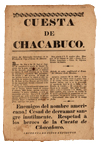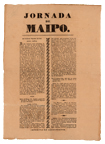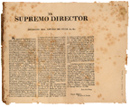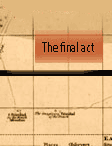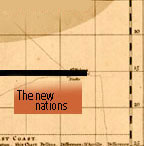| |
The Age of Spanish American Revolutions:
Renewed push for independence
Patriot forces had been thwarted in their attacks northward through Upper Peru (present-day Bolivia) and in 1814 José de San Martin began organizing with different tactics: an attack on Chile, west from Argentina by crossing the Andes. The assault began in January 1817, and by April of the following year, Royalist forces had been so thoroughly defeated that Santiago was secure and only sparse remnants remained.
Similarly, in Northern South America, Simón Bolívar led a force from Venezuela to liberate New Granada from June to August 1819, ending with a decisive victory at the Battle of Boyacá. Bolívar had convoked the Congress of Angostura months earlier, in February of 1819, and with Bogota secure, the Republic of Colombia (consisting of present-day Venezuela, Colombia and Ecuador) was proclaimed on 17 December 1819. |
|
|

The Third Phase Begins
[La Plata, Declaration of Independence] in: Pradt, Pièces rélatives à Saint-Domingue et à l'Amérique (A Paris: Chez F. Béchet, libraire, Quai des Augustins, no. 57. Et à Bruxelles, chez Le Charlier, libraire. Démat,imprimeur-libraire, 1818).
Although the May revolution of 1810 initiated La Plata’s push for independence, a formal declaration was not made until 9 July 1816. At least symbolically, this declaration may be seen as a renewal of the Republican push for independence.
|
|
| |
|
|
|
West to Chile
Mendoza (Argentina), Cuesta De Chacabuco: Oficio del gobernador intendente de la provincia de cuyo al exmo. sr. director. (Buenos Aires: Imprenta de Niños Expositos, 1817).
Republican forces had been continuously thwarted in attempts to push northward through Upper Peru. In a change of strategy, the Army of the North became the Army of the Andes, crossing the high mountain range to the west—and suffering severe losses in the process—in an attempt to retake Chile. Led by José de San Martin, this broadside celebrates the Army’s victory at Chacabuco on 12 February 1817. |
|
| |
|
|
|
Squelching Rumors
Proclamas del supremo director de Chile, y del general San Martín (Buenos Aires?: s.n, 1818).
The Republican victory at Chacabuco was followed, however, by stunning defeat in the Second Battle of Cancha Rayada. Following the battle, rumors circulated that both San Martín and fellow leader Bernardo O’Higgins had been killed. This broadside penned, by both men, urges the troops not to dispair.
Acquired with the assistance of the JCB Associates |
|
| |
|
|
|
Decisive Victory
Jornada De Maipo (Buenos-Ayres: Imprenta de los Expositos, 1818).
Provincias Unidas del Río de la Plata, Nuevo parte del exmo. sr. capitan general de los Andes al gobierno supremo. (Buenos Aires: Imprenta de los Expositos, 1818).
Less than one month later, however, on 5 April 1818, a resurgent Patriot force under San Martín definitively defeated Royalist forces under Mariano Osorio at Maipú, ensuring Chile’s independence.
Acquired with the assistance of the Harper fund |
|
| |
|
|
|
Chile declares independence
Chile, El supremo director delegado del estado de Chile &c. &c.: Se aproxima ciudadanos el memorable 12 de Febrero (Santiago de Chile: s.n, 1818).
On the one-year anniversary of the victory at Chacabuco, even before the decisive victory at Maipú, Chile officially declared independence. This broadside describes the festivities to occur, including military parades, artillery salutes and a formal swearing of an oath to sustain the declaration of independence. |
|
|
To next section: The final act |
|

